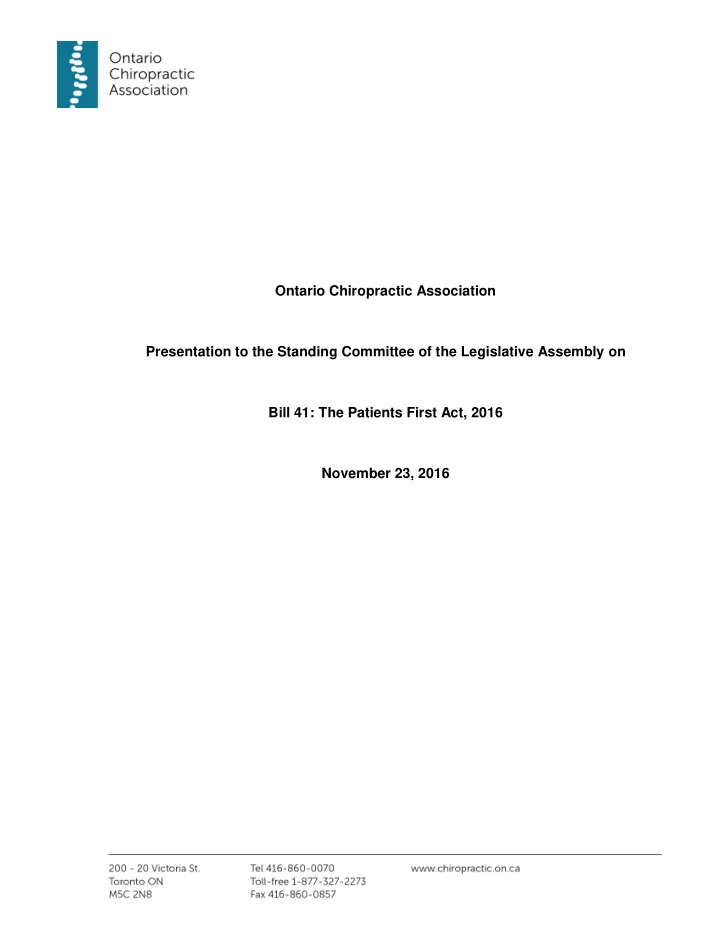

Ontario Chiropractic Association Presentation to the Standing Committee of the Legislative Assembly on Bill 41: The Patients First Act, 2016 November 23, 2016
Page 1 Good Afternoon, The OCA is recommending two amendments to Bill 41 to remove barriers and enable patient- focused integrated care for low back pain and other musculoskeletal conditions. The amendments will enable LHINs and other agencies to utilize chiropractors. BACKGROUND One in five Canadians suffer from chronic non-cancer pain with back pain as a leading condition. 1, 2 : Three of the top four causes of disability in North America are musculoskeletal in nature including low back and neck pain. 4 Evidence points to back pain as a leading reason for opioid prescriptions. A recent study found that 50% of people prescribed opioids in the United States reported back pain. 12 However, according to the new 2016 Centres for Disease Control and Prevention ’s Guideline for Prescribing Opioids for Chronic Pain, the use of nonpharmacological therapies is preferred. 13 With the opioid situation in Canada described as a crisis, the importance of non- pharmacological therapies is highlighted by the Canadian Chiropractic Association being invited to the National Opioid Summit last weekend and being a signatory to the Joint Statement of Action. Chiropractors are educated, trained, and competent to provide MSK assessment, diagnosis, and treatment. They offer a compelling option for better managing MSK conditions across the healthcare system. The literature supports that spinal manipulation therapy (SMT) or adjustments are effective in relieving pain and improving function. 14 SMT is recommended by numerous clinical practice guidelines, including the Bone and Joint Decade Task Force 15 , and the American College of Physicians. 16 ONTARIO'S LOW BACK PAIN PILOTS There are currently two Ministry pilots aimed at improving care of low back pain: the Inter- professional Spine Assessment and Education Clinic (ISAEC) pilot, and the Primary Care Low Back Pain (PCLBP) pilot. Both integrate chiropractors in key clinical roles.
Page 2 ISAEC The ISAEC pilots have demonstrated that engaging chiropractors and advanced practice physiotherapists in assessment and education of low back pain patients decreases unnecessary diagnostic imaging, specialist visits, and their associated costs. 17 PCLBP The PCLBP pilot integrates chiropractors and other practitioners into inter-disciplinary primary care settings, and provides a comprehensive assessment and treatment model. In addition to back pain, the "typical" PCLBP pilot patient suffers from significant co- morbidities including other MSK conditions, diabetes and other chronic diseases, and mental health and addictions issues. Many have characteristics similar to high cost users of the health care system. 18 In addition to decreased specialist referrals, reduced unnecessary diagnostic imaging, the PCLBP pilot is also indicating reduced use of opioids. PROPOSED AMENDMENTS TO BILL 41 Our two minor suggested amendments to Bill 41 and Acts amended by The Bill reflect the key principles of: Eliminating barriers; Building evidence informed solutions; and Developing inter-professional care pathways across the healthcare continuum. Currently, patient access to optimal care is limited by the eligibility requirements for Ministry or LHIN funding. This barrier prevents patients from accessing health professionals who may be the most qualified. This is because eligibility for funding is limited to specific professions, as opposed to being determined by patient need, practitioner competence, and best use of health human resources. Homecare and Community Services Act, 1994 Under the Homecare and Community Services Act , unlike services delivered by physiotherapists, occupational therapists, social workers and nurses, services delivered by chiropractors are not listed as “professional services . ” This means that an approved agency, such as a CCAC (or a LHIN following a transfer order under Bill 41) is not authorized to purchase chiropractic professional services and; therefore, patients cannot access them as they can physiotherapy services. It means even though chiropractors are on the list of eligible practitioners to be hired in Family Health Teams, Community Health Centres, Aboriginal Health
Page 3 Access Centres, and Nurse Practitioner Led Clinics, they do not qualify for funding under the Home Care and Community Services Act, 1994. We know that technically this can be changed by regulation but we also know that there have been no changes made to the Regulations since 1999. Given the success of the Ministry’s current LBP pilots and the thrust of the provincial low back pain, chronic pain, and opioid strategies, we believe this is a significant gap in the provision of appropriate care for Ontarians. Therefore, we recommend that Bill 41 include an amendment to the Home Care and Community Services Act, 1994 to: Include chiropractic services under “professional services” in Section 2 (1) (7) . Local Health System Integration Act, 2006 (LHSIA) Historical funding arrangements mean that, chiropractic clinics are not defined as “health service providers” and, this creates barriers and inconsistencies in patients’ access to appropriate care. Section 1 (3) of Bill 41 repeals Paragraph 11 subsection 2 (2) of the definition of “health service provider” under the Local Health System Integration Act, 2006. Bill 41 substitutes Paragraph 11 by adding several new entities to the definition of “health service provider” , including: (16) “A person or entity that provides physiotherapy services in a clinic setting that is not otherwise a health service provider.” We understand the rationale for this to be housekeeping in that it will allow current funding arrangements to be continued, but it limits the ability to implement new and innovative models. Therefore, we recommend that: Section 1(3) of Bill 41, which amends Paragraph 11 of Subsection 2(2) of the Local Health System Integration Act, 2006, be amended by including “musculoskeletal care” and/or “musculoskeletal services” as follows: 16. “A person or entity that provides musculoskeletal services in a clinic setting including physiotherapy services or chiropractic services ” that is not o therwise a health service provider.”
Recommend
More recommend